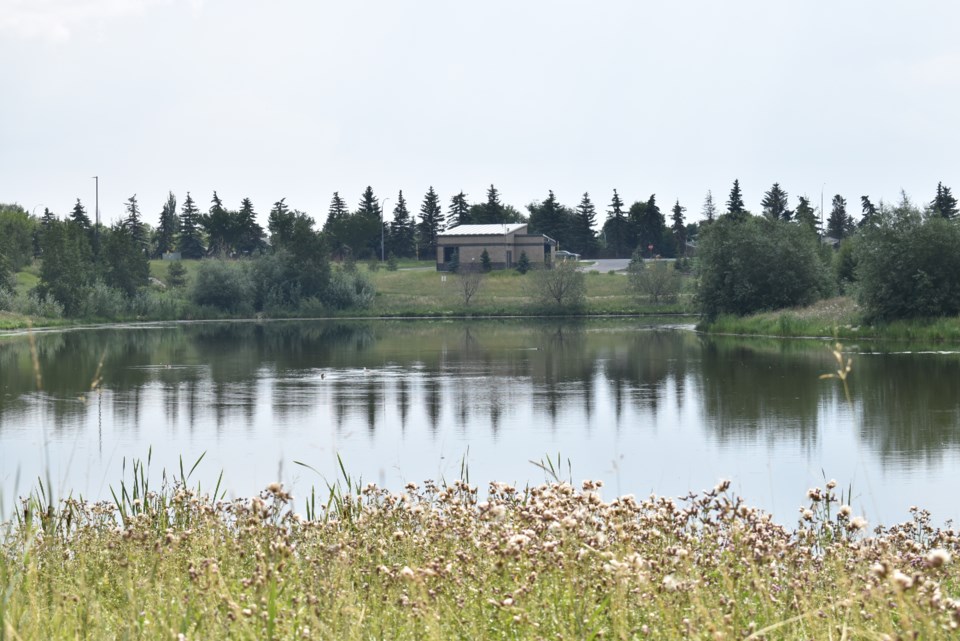St. Albert hopes to make more water available over the summer and during emergencies with help from a provincial grant.
When it comes time to talk budget 2025, city councillors will be asked to approve spending 30-cent dollars on an improvement to the Jensen Lift Station on Villeneuve Road that would allow crews to fill non-potable water trucks with stormwater runoff.
Today, public works water trucks tap into fire hydrants to draw potable water from the municipal system to conduct dust suppression, to water trees, plants and sod and to flush sewer mains.
The city’s proposal was among 18 that will be 70-per-cent funded by the province’s Drought and Flood Protection Program (DFPP), which promises to make $25 million available in each of the next five budget years.
Regan Lefebvre, St. Albert’s senior manager of utilities, is hopeful council will approve the project. He said it falls in line with their strategic plan, which includes adapting to a changing natural environment (having $87,600 of provincial money in-hand doesn’t hurt the business case, either).
“We’re always trying to find innovative ways to reduce our carbon footprint, protect our waterways and green spaces and ensure resilience in our social systems and infrastructure,” Lefebvre said Wednesday. “This will reduce critical demand on the potable water supply.”
The amount of water in question isn’t immense: Lefebvre said the 1,000 cubic metres or so of water the system would replace for those previously mentioned uses amounts to what four homes would consume over the summer. Plus, that only accounts for a portion of the water the city draws for those purposes; some water trucks would still hook into the hydrant system.
But in an emergency, every drop counts. Lefebvre compared it to the situation in Calgary in June, when a critical water trunk broke and put Alberta’s largest urban centre under severe restrictions for weeks.
“They had rented equipment pulling water out of four different stormwater management facilities,” Lefebvre explained. “We’re building a permanent facility where this will be possible.”
The new system would also allow city crews to continue their work when more routine water restrictions are in place. Those restrictions take effect on municipal crews before residents are asked to limit their own use, which “can be disruptive.”
By using non-potable water drawn from the Jensen station, dust suppression and plant watering could continue without putting pressure on the potable water supply.
Lefebvre expects the work to the lift station, which will include the installation of a submersible pump, a filtration system and controls, to take place in 2025, pending council approval.
Big money, small places
The DFPP is aimed at towns, cities and Indigenous communities with populations under 500,000. Of the total to be awarded this year, $10 million is earmarked for rural municipalities.
This is good news to Alberta Municipalities, according to the group’s president, Wetaskiwin Mayor Tyler Gandam.
“Our member-municipalities know best how to invest in local infrastructure projects, so we appreciate these funds being made available for direct application to the most pressing needs,” he said in an Alberta government press release. “Funding from the province that will be used to protect Alberta’s communities from droughts and floods eases the financial burden on the already stretched budgets of local governments.”
The money is meant to help municipalities protect or relocate critical infrastructure such as water and stormwater works and the roads used to access them, and to build berms, flood walls and riverbank protection, retention ponds and diversion structures.
Some of the most pressing needs in the province – judging by the size of the grants they’re receiving this year, at least – exist in and around Brooks, where new stormwater mains and retention ponds will be built ($4 million), Fort Mckay north of Fort McMurray, where a new water intake and pumphouse will be installed in the Ells River ($10 million split evenly between this fiscal year and next), and Langdon in Rocky View County, where improved ditches and culverts will aim to create enough runoff capacity to handle a 100-year storm ($4.2 million this year, $700,000 in 2025-26).
RJ Sigurdson, provincial minister of Agriculture and Irrigation, said in the release his government is committed to protecting Albertans from flooding and drought conditions.
“This funding will help support the resiliency of our water management infrastructure in order to mitigate risks, reduce the disastrous effects of floods and drought, and ensure that Albertans consistently have a safe supply of water available.



